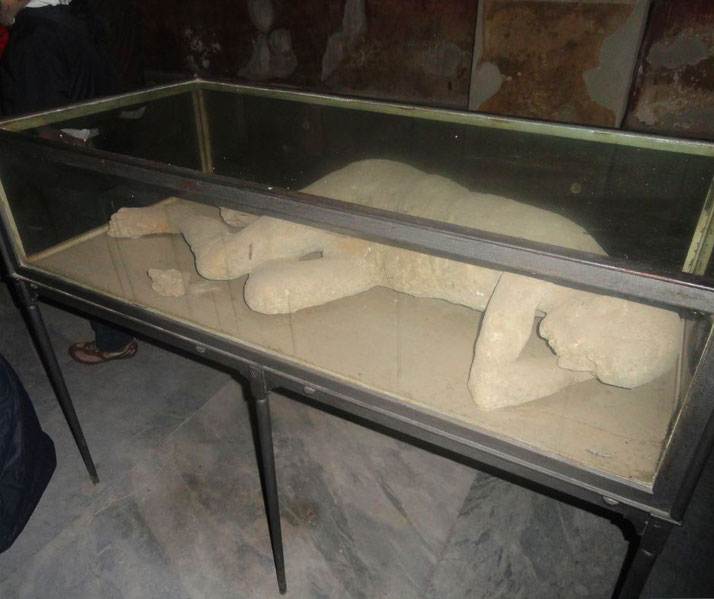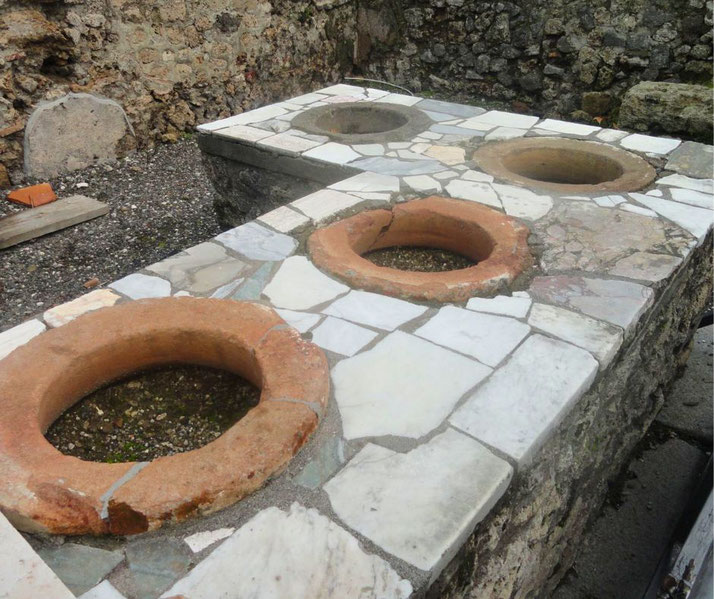The archaeological miracle of the ruins of Pompeii

On August 24, AD 79, a catastrophic event destroyed an entire Roman community. It was on this date that a volcano, called Mount Vesuvius erupted and buried the ancient city of Pompeii.
In just one day, it was covered under a thick layer of volcanic ash and rock that was metres deep. By sheer chance, the event froze the city in time.
This lost world lay hidden and unknown for over 1000 years, until the first clues were suddenly rediscovered in 1599 by Domenico Fontana.
Still, it would not be until 1748 that people realized the shocking extent of what had occurred in this Roman settlement on that horrific day.
What was Pompeii?
Before the events of AD 79, the city of Pompeii had enjoyed a long history. It is believed that the site was first settled in the 7th century BC by a group of Italian settlers, called the Oscans.
Pompeii's strategic location in a sheltered bay in the coast of Naples gave it unprecedented access to the wider Mediterranean Sea.
As a result, it quickly transformed it into an important trading center. Even though it existed in the shadow of the volcano Vesuvius, it had been a long time since it had erupted.
Therefore, people felt secure enough to live there and invest in growing the city. In fact, the volcanic soil around Pompeii made it ideal of large-scale agriculture.
Soon, through its success as a port for ocean trade and the wealth it generated from farming, attracted the attention of the nearby cultures of the Greeks, Etruscans, and Samnites.
Eventually, it came under Roman control and continued to thrive for centuries.
By the time of the disaster, Pompeii was a significant city. It was home to a population of around 11,000 to 15,000 people, including Roman citizens, freedmen, slaves, and foreign residents.
As a cosmopolitan centre, the inhabitants from all walks of life were living and working side by side.
But then the unthinkable happened...
How Pompeii was buried
What surprises most modern people is just how much we know about the disaster that destroyed the city.
The reason why we have such incredible detail about the event is because there are two main sources of evidence.
The first is the archaeological evidence that survives due to the fact that it was buried during the eruption.
The little details about the damage to buildings, the residue that consumed the city, and the fate of many who were still in the houses and streets, were all frozen in time.
As a consequence, archaeologists can examine each piece of evidence in order to gradually reconstruct what happened on that day.
Thanks to this unpredicted level of detail, historians are able to determine that the violent volcanic eruption of 79 AD occurred in two main phases.
The first phase is referred to as the 'Plinian phase', during which a towering column of pumice and ash.
It began on the morning of August 24, 79 AD. When the initial violent and loud explosion from the mountain occurred, the people in Pompeii watched a column of dense black smoke rise from the crater of Mount Vesuvius.
This first phase lasted for approximately 18 hours, and gradually deposited pumice and ash over Pompeii and its surroundings.
During this time, the air was filled with falling debris, making it difficult for the inhabitants to breathe and see.
In addition, the air temperature increased significantly, and visibility was reduced to almost zero.

The second phase which followed was known as the 'pyroclastic flow phase'. As the sheer volume of super-heated ash and pumice in the atmosphere became too dense, the column began falling back down to earth again as it collapsed in on itself.
As the atmospheric debris falling down collided with the erupting debris still vomiting into the sky, it generated a series of fast-moving currents of hot gas and volcanic matter that flowed out from the mountain and towards the nearby towns.
These pyroclastic flows rushed down the slopes of Mount Vesuvius and may have reached speeds up to 700 km/h (430 mph) with temperatures of about 1,000 °C (1,830 °F).
As the waves of super-heated gas and rock swept through the streets of Pompeii, the residents still in Pompeii would have been killed instantly by thermal shock.
Once everyone was annihilated, the constant rain of pumice from the sky eventually buried the entire city under a thick layer of volcanic material.
As a result, the bodies of the victims were permanently preserved by the ash. As the centuries passed, the bodies decomposed and disappeared.
However, the ash around them retained the shape of the bodies they had buried.
In fact, in some cases, the creases of their clothing and the items they had on them were still visible in the imprints in the ash.
Who were Pliny the Elder and Younger?
Even though the archaeological record provides us with a phenomenal level of detail about the day of the eruption, a rare written account survives as well.
This is the second source of our information about Pompeii, and it allows us to corroborate the findings from archaeology.
The written explanation of the burial of Pompeii comes from a Roman who was living near Pompeii at the time.
His name was Pliny the Younger. He was living with his uncle, called Pliny the Elder, at a place called Misenum, which was located in the same bay as Pompeii, but was on the other side of the Bay of Naples and was far enough away that it was safe from the eruption.
However, when the disaster occurred, Pliny the Younger's uncle was the Roman admiral for the region.
That meant that he was in command of the nearby fleet of navy ships and was expected to help out in any such disaster.
Upon hearing of the eruption, Pliny the Elder decided to investigate, while his nephew, Pliny the Younger, was ordered to remain behind to remain safe.
As Pliny the Elder sailed towards the erupting volcano, he knew he was heading into a very dangerous situation.
While helping evacuate Roman citizens, Pliny the Elder's curiosity got the better of him and he sailed close to Pompeii to investigate.
Sadly, he was overcome by the dense fumes and died.
However, Pliny the Younger survived and later in life, recorded his uncle's final hours in a letter to his friend Tacitus, who was a Roman historian.
This invaluable firsthand information about the disaster provides a detailed summary of the column of ash and pumice rising into the sky, and the eventual collapse into the pyroclastic currents.
Amazingly, this matches the archaeological findings exactly.
How was Pompeii rediscovered?
More than a millennium and a half after it was buried by Vesuvius, the first signs of Pompeii existence came to light 1599.
An Italian man called Domenico Fontana was able to dig up evidence that a buried city was lying somewhere in Naples.
This was followed by a more systematic excavation that began in 1748 by Rocque Joaquin de Alcubierre.
Finally, the first large-scale excavations begun in 1860, under the archaeologist Giuseppe Fiorelli.
He introduced a number of revolutionary archaeological methods to try and preserve as much of the finds as possible.
He famously decided to use plaster casts to recreate the forms of the victims who perished in the eruption.
To do this, his team would identify an empty cavity in the volcanic rock that they believed was where a body had once lain.
Then, they would mix together a liquid form of Plaster of Paris and pour it into the space until it was full.
They would wait for it to set, by which case it would become solid, so that they could then remove the volcanic soil around it.
These plaster casts, therefore, preserved the imprint from the bodies that had vanished long ago.

How archaeologists have revealed Pompeii's secrets
In addition to the body casts, there is a treasure trove of artifacts that have gradually unraveled many of Pompeii's secrets.
The most obvious remains from the city are its dozens of well-preserved buildings, detailed artwork on house walls, and even wooden furniture.
These have given historians incredibly rare glimpses into the everyday lives of its people.
In fact, Pompeii is home to some of the most striking examples of Roman architecture in all of Europe.
There are examples of what temples, public baths, roads and wealthy people's villas would have looked like 2000 years ago.
In addition, there are incredible remains from the poorer classes as well. In fact, there is a surprising number of graffiti scratched into the walls all around the city.
These include declarations of love, political slogans, curses and insults, as well as children writing down who their favourite gladiators were.
This is a unique insight into the lives of people from all walks of life in a way that is not found in any other Roman ruins.
Also, a number of more recent scientific techniques have significantly enriched our understanding of the people who lived in ancient Pompeii.
Analysis of food remains have revealed details about their food and diet. This is because Pompeii was home to numerous thermopolia, which were a kind of ancient fast-food establishment.
Here, residents could purchase hot meals and drinks. Amazingly, some of the foods pots still had residue from the products they held when they were rediscovered.
So, archaeologists could send these traces to a scientific lab to discover what Roman people were buying when they were hungry.
As a result, Pompeii offers a remarkable glimpse into the past, as it is a valuable time capsule of the Roman Empire.
Today, the archaeological site of Pompeii attracts over two million visitors every year and generates significant revenue for the local economy.

What are the key sites at Pompeii?
For those people who are lucky enough to travel to Pompeii, here are some of the most famous locations within the ruins:
The Forum: This was the heart of public life in Pompeii. The Forum was a large open space surrounded by grand temples and important government buildings.
The Basilica: This large building was used for public meetings and legal proceedings.
The Temple of Jupiter: This was the largest temple in Pompeii, dedicated to the Roman god Jupiter.
The Amphitheatre: A large arena used for public entertainment, such as gladiator fights and animal hunts.
The Baths of Pompeii: These were a series of public baths used for cleansing and relaxation.
The Villa of the Mysteries: Discovered in 1909, this wealthy person's house contains some of the best-preserved frescoes in Pompeii. Some of them depict strange scenes believed to be related to Dionysian rituals.
The House of the Faun: This is one of Pompeii's most famous residences. It was discovered in 1830 and is renowned for its elaborate mosaics, including the celebrated Alexander Mosaic depicting the Battle of Issus.
Herculaneum: The other city buried by Vesuvius
Herculaneum, a city located west of Pompeii, was also decimated by the eruption of Mount Vesuvius.
Herculaneum, which was rediscovered in 1709 by laborers digging a well, was found to be a much smaller settlement than Pompeii.
While both cities were buried under a thick layer of ash and pumice, Herculaneum was preserved differently due to being covered by a mixture of ash and mud.
While Pompeii offers a broader perspective due to its size, the state of preservation in Herculaneum is often considered superior, with better preserved wooden structures and household objects.
Further reading
What do you need help with?
Download ready-to-use digital learning resources
Copyright © History Skills 2014-2025.
Contact via email
With the exception of links to external sites, some historical sources and extracts from specific publications, all content on this website is copyrighted by History Skills. This content may not be copied, republished or redistributed without written permission from the website creator. Please use the Contact page to obtain relevant permission.





